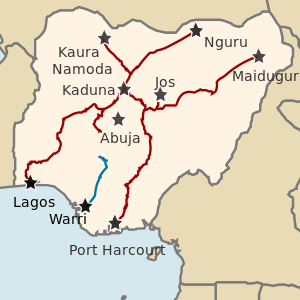Rail transport in Nigeria

Railways in Nigeria are operated by the Nigerian Railway Corporation. Nigeria's rail system consists of 3,505 km of 3 ft 6 in (1,067 mm) gauge lines and 479 km of standard gauge lines. Efforts are underway to rehabilitate the Cape gauge network and construct a new standard gauge network.
National network
Cape gauge
The Nigerian railways were originally built by the colonial power, Great Britain. The railways were built to the 3 ft 6 in (1,067 mm) Cape gauge, the same track gauge used in most other British colonies in Africa.
The country has two major Cape-gauge rail lines. The western line connects Lagos on the Bight of Benin and Nguru in the northern state of Yobe. The eastern line connects Port Harcourt in the Niger Delta and Maiduguri in the northeastern state of Borno. A linking line connects Kaduna on the western line to Kafanchan on the eastern line.
There are no railway links with adjacent countries. Nigeria does not use the same track gauge as its neighbors, where the French and German imperialists built metre gauge railway networks. There were plans to establish rail links to Niger through Illela in Sokoto state and Cameroon, but these have not yet been built.
Standard gauge
A standard gauge railway connects the national capital of Abuja to the city of Kaduna, an important junction point on the Cape gauge railway network. This is the first segment of the planned Lagos–Kano Standard Gauge Railway to be completed.
History
Construction
The British government began construction of a railway from Lagos Colony to Ibadan in March 1896. The Lagos Government Railway began operations in March 1901 and was extended to Minna in 1911, where it met the Baro–Kano Railway that was built by the government of Northern Nigeria between 1907 and 1911.[1] The two lines were amalgamated in 1912 into the Government Department of Railways, the predecessor to the Nigerian Railway Corporation. The railway reached its northeastern terminus of Nguru in 1930.[2]
After coal was discovered at Udi, the Eastern Railway was built to Port Harcourt between 1913 and 1916. This railway was extended to Kaduna in 1927, connecting the Eastern Railway to the Lagos–Kano Railway.[3] The Eastern Railway was extended to its northeastern terminus of Maiduguri between 1958 and 1964.[2]
Decline
Years of neglect of both the rolling stock and the right-of-way have seriously reduced the capacity and utility of the system. Couplings of the chopper kind, vacuum brakes and non-roller bearing plain axles are also obsolete. By early 2013, the only operational segment of Nigeria's rail network was between Lagos and Kano. Passenger trains took 31 hours to complete the journey at an average speed of 45 km/h.[4][5]
Rehabilitation
A project to restore Nigeria's railways has been underway since 2009. The eastern line from Port Harcourt to Maiduguri was restored at a cost of US$427 million by Lingo Nigeria, Eser West Africa, and the China Gezhouba Group.[7]
In order to remedy the poor condition, efficiency, and profitability of the nation’s railroads, the government is also seeking to privatize the Nigerian Railway Corporation. Under the privatization plan, the railways will be split into three concessions, each to be awarded for a period of 25-30 years.[8]
Standard gauge network
In 2006, the government contracted with the China Civil Engineering Construction Corporation to build the Lagos–Kano Standard Gauge Railway. It was later decided to complete the project in segments due to a lack of funds. After many delays, the segment from Abuja to Kaduna (187 km) opened officially on 26 July 2016.[9] Other segments have not yet begun construction.
Metro systems
Several metro systems are under construction:
Maps
See also
References
- ↑ Carland, John (1985). The Colonial Office and Nigeria, 1898-1914. Hoover Press. pp. 135–183. ISBN 9780817981433.
- 1 2 Yakubu; et al., eds. (2005). Northern Nigeria: A Century of Transformation, 1903-2003. Kaduna, Nigeria: Arewa House, Ahmadu Bello University. p. 352. ISBN 9789781351426.
- ↑ Chuku, Gloria (2015). Igbo Women and Economic Transformation in Southeastern Nigeria, 1900-1960. p. 156. ISBN 9781135469405.
- ↑ Ross, Will (13 February 2013). "Can Nigeria's renovated railway unite north and south?". BBC.
- ↑ "A slow but steady new chug". The Economist. 9 February 2013.
- 1 2 Komolafe, Oladayo (17 February 2015). "Overseeing the resurrection of Nigerian railways | NAN". News Agency of Nigeria.
- ↑ Oirere, Shem (October 1, 2014). "Insurgents threaten reopening of Nigerian line". International Railway Journal.
- ↑ Smith, Kevin (16 February 2015). "Privatisation bill for Nigerian railways approved".
- ↑ "President inaugurates Abuja – Kaduna railway". Railway Gazette.
External links
![]() Media related to Rail transport in Nigeria at Wikimedia Commons
Media related to Rail transport in Nigeria at Wikimedia Commons